Today – October 15 2020 – we learned that our dear friend Franco Ghisalberti passed away. He was 93 years old. We are deeply saddened for his family and his oh so many friends – many of whom also felt like, and were treated like, family. That is certainly the case for Jaci and me. You’ve read about our adventures on Harpguitars.net, which I always tried to instill with our shared emotions, passion and excitement. Indeed, we accomplished an incredible amount of work, and had so much fun along the way! But no one really knows the full, wonderful “strange but true story” of Franco Ghisalberti and Gregg Miner.
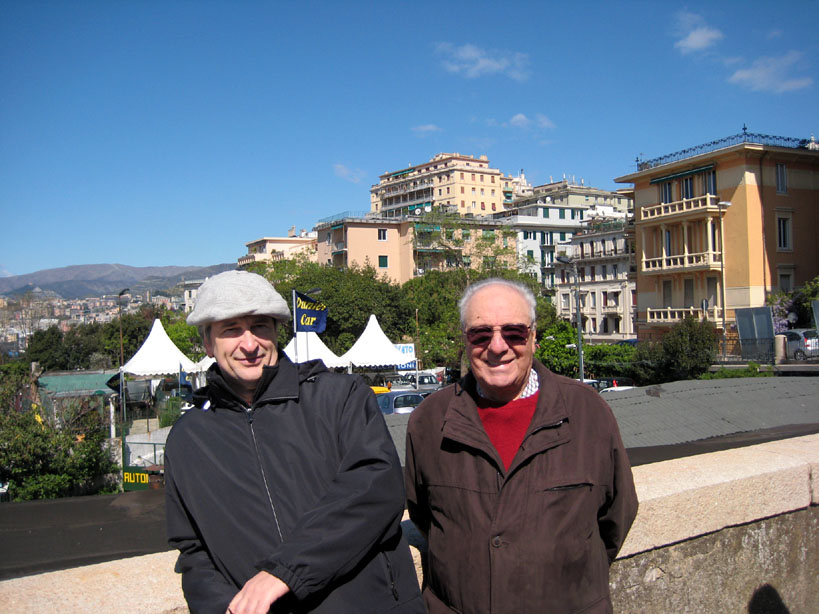
Back in the early 2000s, when I had begun my harp guitar research in earnest: Michael Simmons showed me the fabled blue CD – the first ever conversion of some of the 78 recordings of the mysterious virtuoso of Genoa, Pasquale Taraffo. At that time, virtually no one in America had heard of him. Michael said to try and get a copy from Beppe Gambetta who had been handing them out to friends (which I did). That was my introduction to Beppe, who happened to then live in Genoa (when not touring as a famous flatpicking guitarist). Of course, it was Franco who had made that CD (from his own record collection), but that wouldn’t register until much later.
Through Harpguitars.net I shared what scraps of information we could dig up about Taraffo, his music and his instrument. It wasn’t much. At that time (the “Taraffo Dark Ages”), there was only the rumor that Taraffo somehow did his “impossible” continuous tremolo – over bass and chords – with his ring finger acting as a mandolin pick! This “fable” in fact came from guitarist Fabrizio Giudice – but it was in reference to a different Taraffo technique. Back then, all this was simply an unsolvable mystery from another time, another language, another country. I wouldn’t have imagined in a million years that it would be I – with all the incredible friends and colleagues I would eventually encounter – who would one day present the answers to these mysteries (most, anyway!) through our documentary Secrets of Taraffo.
Shortly after the blue CD discovery, I was treated (through Michael again) to a top-secret private viewing of a copy of the legendary film clip of Taraffo performing a minute’s snippet of one his pieces. It took another year for me to track down the original source and subsequently license it for restricted viewing for Harpguitars.net members. (Beppe’s wife later tracked it down also and licensed a bit of it for Dan Crary’s Primal Twang concert/DVD. That clip was simply gold. And just last month, the owning library themselves (U of SC) digitized and published the clip on their server here.)
Around 2007(?), Franco emailed me about the great job I had done with Harpguitars.net and the (tiny) section on Taraffo. He introduced himself and told me of his interest in the topic – which I would eventually learn was a passion bordering on obsession (Gee, remind you of anyone?). It soon became clear that Franco was the source on Taraffo – not only the creator of that original CD, but biographer, collector and producer. It was now time for him to publish his archives of photos, ephemera, documents and information, and what were my thoughts on the idea of his doing a book?! Well, he and I being kindred spirits and obsessive nerds, passionate and blunt, the answer rather quickly presented itself. We would create his “book” on my web site (the main point that convinced him was the ability to quickly and easily correct and add to it…which we did). He and his volunteers provided both Italian and English text and captions and I did the rest. It was my second bi-lingual major article on Harpguitars.net and forever a place of pride.
After the pages were up (with his proud blessing), Franco began laying plans for something unprecedented in Genoa: a public harp guitar exhibit to garner interest in the city’s forgotten musical legacy – Pasquale Taraffo. In 2009 we had just started the Harp Guitar Foundation, and Franco was insistent that the president (of the now-prestigious entity) attend. Jaci and I turned to each other in one of those “Uh…yeah!” moments.
And so the following spring, we were greeted at the tiny Genoa airport by the man himself. He had hired his friend and the city’s best translator, Sylvia, to be our constant guide and companion. And boy, did I need it! (Jaci’s great with other languages, I’m pretty much a lost cause). Franco himself uses Google translate both ways (as I do), but could converse fine in English, and his daughter and granddaughter were even better.
I wrote about the trip on my first Genoa blog – that one took 15 chapters! I had forgotten that I was surprised there by the news that I was to give a speech. You know me – they laughed, they cried, and I got my name in the paper (and not the last time in Italian for this now-famous American!).

By the end of those 10 days we had met most of the luthiers in Genoa, Franco’s family, Margarita, and many of his special friends, including the Bassos (who kindly sponsored our hotel and arrangements). And we’d fallen in love with the city. What we hadn’t anticipated was being welcomed not as “the American harp guitar nerd and his wife” but as honored guests. It was clear that Franco was well-connected and a beloved patron of the arts in his city. And it was clear that he and I were the key collaborators in this little hobby of his. A hobby that had been his passion, and would now become his overriding life’s work. Why? I think because I – and through Harpguitars.net, America and the whole world – took it seriously. Genoa had forgotten Taraffo and his music. Now here was the first public acknowledgment and celebration of that since 1954, when Taraffo’s daughter Stefania gifted his harp guitar to the city, landing in the Conservatory Niccolo Paganini, where it mostly languished in its cardboard box for decades. (I am happy to report that it is now permanently displayed behind glass on a reproduction stand built by Antonello Saccu, along with my original signed, framed Taraffo portrait. And here’s one of many private Franco stories: He and I were rather mortified by the cheap taped-up box the staff brought out Taraffo’s cherished Gazzo harp guitar in. When later that week, we were given gifts of a special delicacy salami (donkey, I later discovered), each packed in an elaborate miniature wooden gift crate, Franco was killing himself laughing that the salami got a better box than Taraffo’s guitar…) But seriously, it was incredibly important to Franco that the English-speaking world finally learned of, and appreciated, the great Taraffo. And, quid pro quo, we guitar fans and researchers owe everything about Taraffo that we know and now have access to, to Franco.
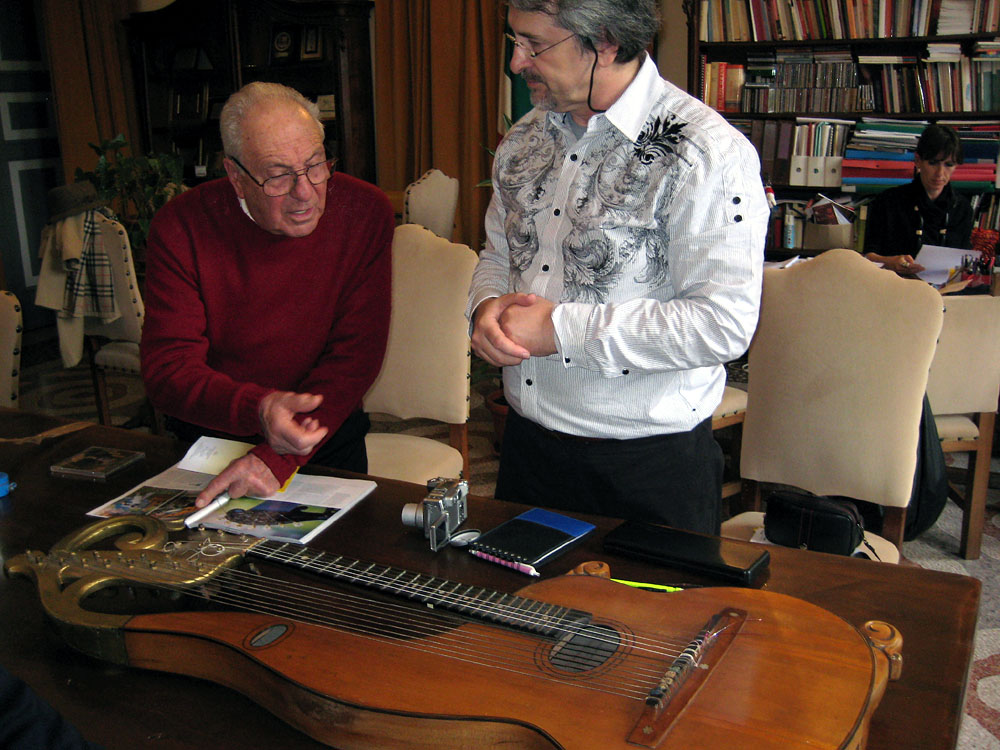
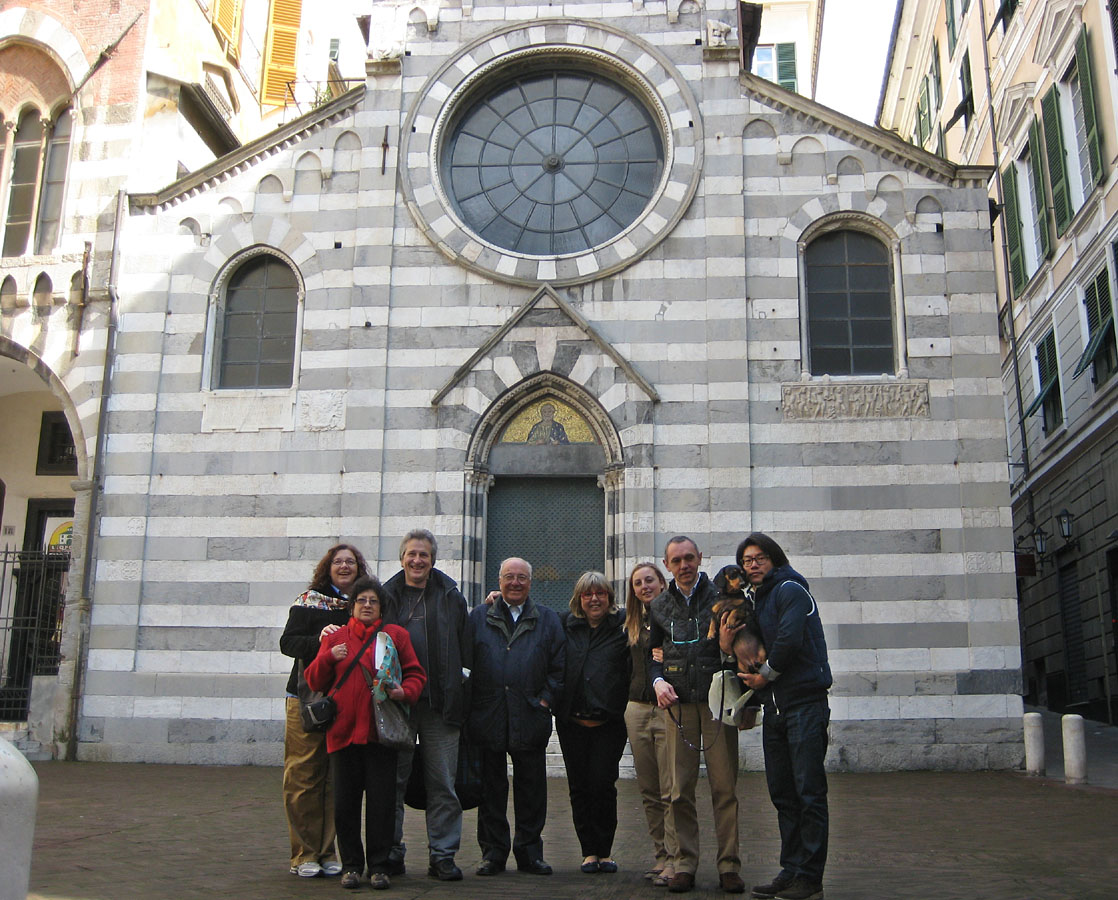
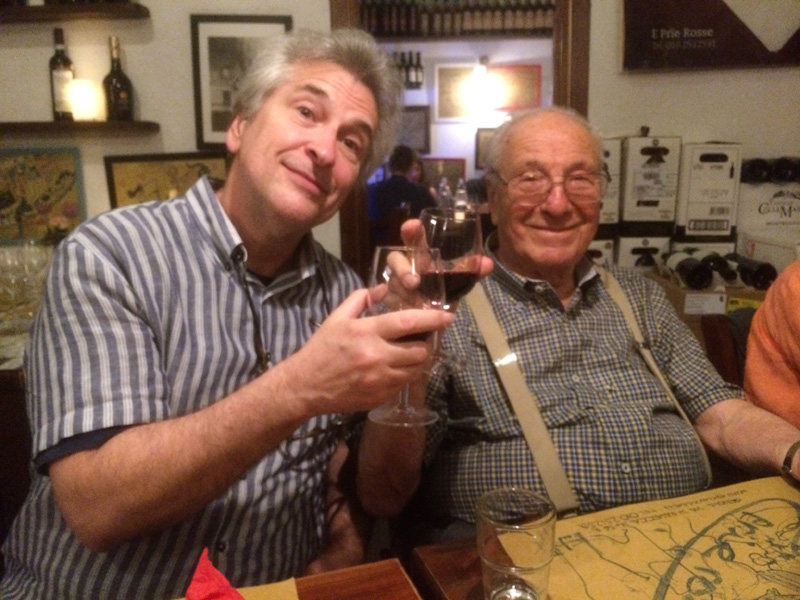
Jaci and I left that first trip feeling like family. After the next trip (two years later, and an excuse to hold a much bigger and better Taraffo event), I was regarding Franco almost like a “second father” and sensed he enjoyed our especially close bond. This was obvious when he would share his treasures (besides his vast record collection, he enjoyed collecting all sorts of things like antique recording devices, cameras and bizarre tools and inventions), and lending me shirts when the weather changed (this is one of his here!) and giving me his hand-me-down razor, etc.
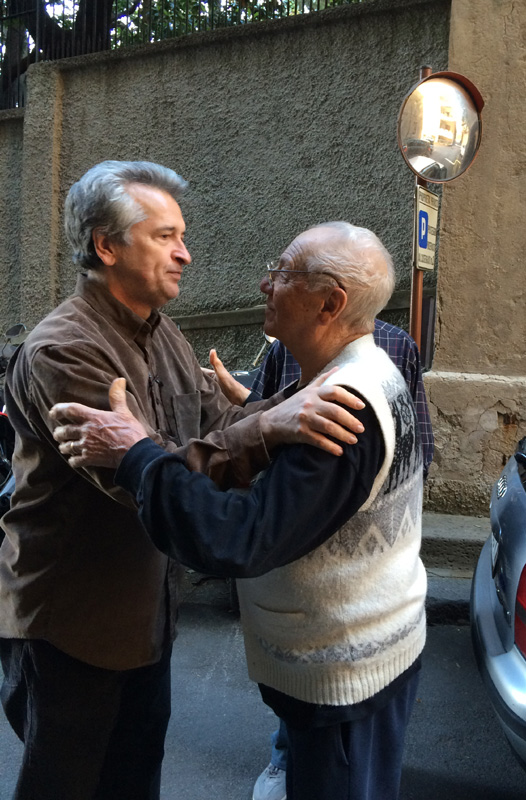
We shared…Taraffo. We could not have come from two more different worlds. Continent, eras, language, religion, politics, music, life experiences – all were polar opposites. So why did we love and respect each other so? I grew up on the Monkees; he grew up on…opera. Certainly my own 93-year-old parents did not grow up on opera. Franco did. In Genoa then, that was the people’s music, their “pop music.” I wouldn’t have known, but Franco shared his childhood records and original player with us (of course he would still have them; he and I are doppelgangers!). His cherished childhood songs and records were all opera. When we stayed with him for the next trips, he would retire early and spend the evening in his special recliner (an American Lazy-boy, he was proud to brag of), watching his opera DVDs. He’d probably heard them a hundred times. I imagine it was like us with the Beatles. You never stop loving those songs no matter how old you get or how many times you’ve heard them. It’s in the very marrow of our consciousness.
Quick backstory: We learned that Franco made his money as a partner in a company that invented and built, among many other things, gas station canopies. You know how you pull in and pump your gas under some sort of shade, right? Those roofs were heavy. Franco’s genius was in simplicity and basic logic. He came up with the corrugated roof. Suddenly those metal covers could be made much ten times lighter and stronger. Yeah, like you woulda thought of it… Thousands of gas stations throughout Italy later and….well, all we know is that Franco had a great place overlooking the harbor and was a generous soul. As a music lover, he then became a dedicated patron of the arts, not just funding, but creating special projects for his talented friends. He put on concerts and especially delighted in any means possible of sharing his beloved operas with new audiences. So he would commission a pianist virtuoso friend to transcribe and record some entire opera – orchestra and vocals – onto solo piano. He seemed most proud of those accomplishments.
And so…why Taraffo? Ah – because Taraffo was the originator of that. Never stated in our collaborative Taraffo section of the web site is that Franco explained that this was Taraffo’s genius (his ground-breaking harp guitar playing was just the conduit). Taraffo was the first to not only distill a popular opera song instrumentally, but he knew how to do it to just fit on a 3-minute 78rpm record. His masterpiece, Franco explained, was “Norma.” It’s the whole damn Overture crammed onto a 78 “side,” interpreted instrumentally and thematically to get “the gist” of the whole thing across. By the way, Taraffo couldn’t read music, he just went home after a couple performances and figured it out. That was what Franco spent the remainder of his life doing everything he could to get his fellow citizens and music lovers to appreciate about Taraffo – be they opera fans, classical pianists, guitarists of every stripe, violinists, conductors, you name it. And he was well-connected in spreading this gospel (he casually introduced us to Andrea Bocelli’s manager at one after-party).
On my behalf, but also because I think he got a kick out of it, Franco also patiently waited while I exhausted every luthier and guitar connection he could track down, knowing that any might yield a clue about Settimio Gazzo’s instruments (Taraffo’s builder) or any other harp guitar history I was always looking for. And he found a lot. He was quite tickled that he became himself a small harp guitar collector, surprising me with his own Gazzo, then a pair of rare Prianos. Franco even finagled for a select group of us to visit collector Giovanni Accornero out in the vast countryside near Alessandria. Now that was a mind-boggling collection and experience (Gianni was already familiar with Harpguitars.net, so at the end of the day we were just a couple of pals swapping Fred Oster stories…). Yes, over the years, Franco (and his friends over there) found a lot of harp guitar stuff for Harpguitars.net.

By our fourth and final visit (Jaci had actually gone on her own again while visiting a museum curator pal in the Netherlands), it wasn’t even about Taraffo, but just about hanging out – family, friends, sightseeing, food and wine. You can get a sense of it from my 4 trip blogs (accessed here), but of course, the reality is a hundred times more magical. We were further inspired by Franco’s neighbors, Jan and Else – Dutch-Americans who had retired after their teaching careers. They had traveled much of the world and planned to continue to do so. Of all the places they’d seen and loved, they chose Genoa as the most perfect, beautiful European city to call home (and they speak about as much Italian as I do, by the way).
We too adore Genoa. We had hoped to go back just for a visit in 2019, then foolishly postponed for the next spring. Ready to book, then the pandemic hit. Make of life what you can, when you can.
Franco obviously loved Genoa from his childhood to his very end. He even put us up for the last trip in a hotel room where across the way he could point to his old bedroom (bombed in the war, but rebuilt). He never stopped his Arts & Humanities patron efforts – his “little projects” he called them, and was always thinking of the next one for the future. Yet he was as in touch with his childhood memories, joy and passion as anyone I’ve met. We grieve for ourselves, his family, his friends – but we honor his memory and legacy, just a small part of which I am humbled to archive on my web site. (I’m now reminded again that our harp guitar work may thus outlive us all – now that’s something to think about.)
Franco never missed a daily walk until his last couple years. And perhaps he may yet be walking those streets still. Certainly he will in the hearts and minds of all who knew him. Look…and you might see him…oh, and I hope to be there too, as often as I can….


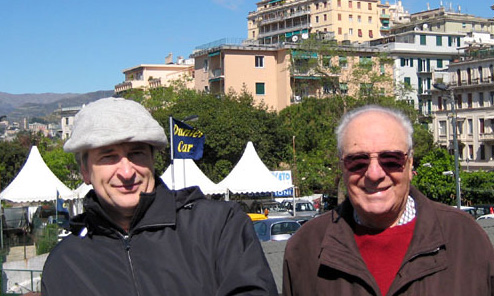
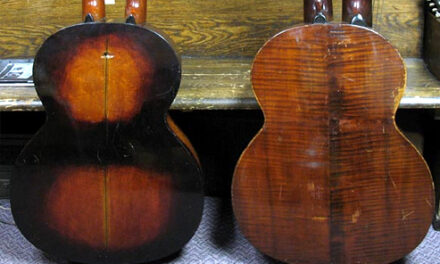
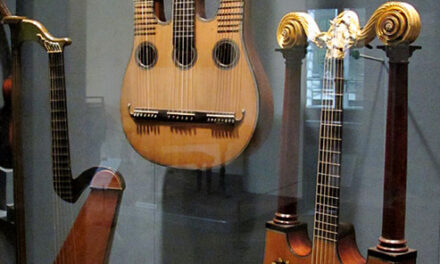
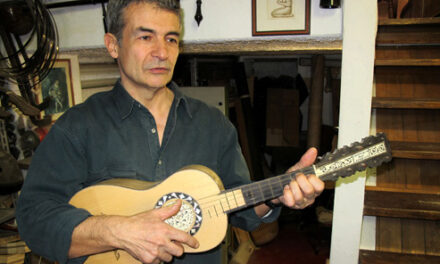
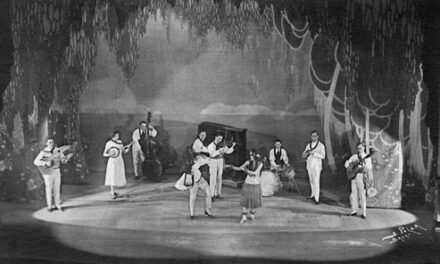
Just splendid . . .and especially moving to read on the very day when we celebrated the wonderful instrument that has tied us to so many wonderful hearts.
Two hearts as one–there is no better definition of shared love than a friendship spawned from like-mindedness.
Cherishing these moments when we know we’ve met a match, isn’t that what we take with us when we leave this earth?
I’m sure he learned much from you as well as you from him. Thank you for this touching story. I am so sorry for your loss of a gentle soul and friend. He kept a light on in a dark corner of Italian music culture and you’re carrying on that tradition.
Sheri~
Meeting wonderful people along the way and building an unforgettable friendship with them brings peace and meaning to your life. Offering my condolence and gratitude.
Gregg,
This is simply beautiful. May your memories of this amazing man and your friendship sustain you. I am so sorry.
xo
Nancy B.
I second what Martin said. Despite the sadness, reading this was a very nice reminder of the many stories that flowed as a result of your relationship with Franco. It also prompted me to look again at your Cavaliere Di Taraffo (Knight of Taraffo) award that I created and Franco signed for you. (https://www.harpguitars.net/2012/12/hgg10-surprise-no-3/)
Sorry for your loss…
A wonderful piece and a fitting tribute. Thanks.